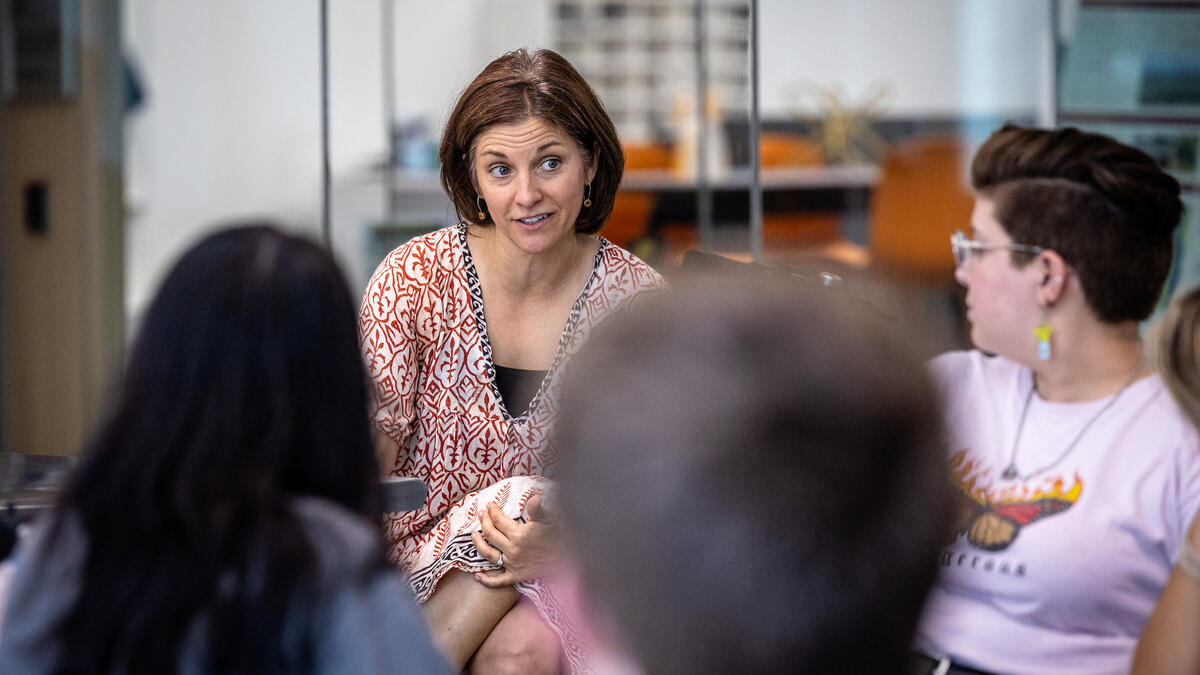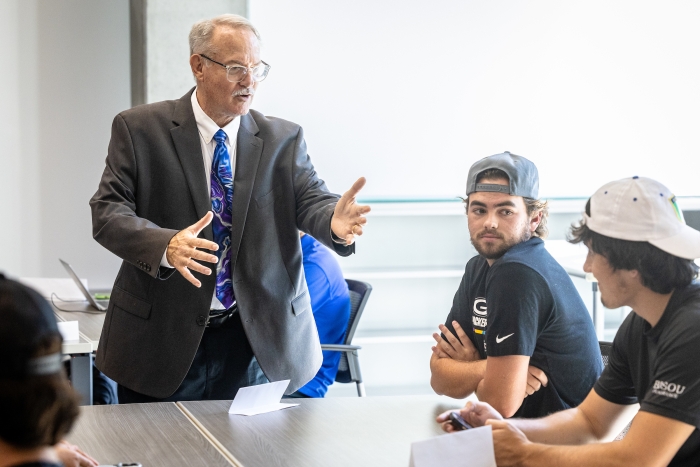Two whiteboards are set up in classroom 409 of the Rob and Melani Walton Center for Planetary Health on ASU's Tempe campus.
The word “motives” is written across the top of one board. The other board is topped by the word “planning.”
One by one, students walk up to the boards and write down FBI statistics:
- Fifteen percent had a desire to kill.
- Thirteen percent were motivated by suicide.
- One percent heard voices in their heads, telling them to kill someone.
- Sixty-three percent of the plotters had unimpeded access to weapons.
As the students discuss what they’ve learned, instructors Sarah Lindstrom Johnson, an associate professor in Arizona State University’s T. Denny Sanford School of Social and Family Dynamics, and James Blasingame, a President’s Professor in the Department of English, occasionally weigh in.
The name of the class is Narrative of School Shootings, and it’s described in the syllabus this way: “Students in this Humanities Lab will investigate the ways that youth interface with the gun violence narrative, from being victims of school shootings, to advocacy, to school-based prevention efforts.” It is the first of a gun violence series out of the Humanities Lab in The College of Liberal Arts and Sciences.
Dean of Humanities Jeffrey Cohen said the series acknowledges the pervasiveness of guns in society but stays away from any political discourse.
“I want to emphasize that this is not about whether people should have gun rights or not,” Cohen said. “It is aimed at the fact that gun violence impacts many communities, including those our students grow up in. How do we prevent people from being innocent bystanders to a culture of violence that can traumatize them and set them back, especially given gun violence’s uneven impacts? It hits students who come from communities of color much harder than it does more affluent, white communities. So what do we do about that?”
Fourth-year English literature student Braden Walker writes down the statistic that 1% of individuals involved in mass school shootings were diagnosed with psychosis, during a Humanities Lab course on Monday, Sept. 11, in the Walton Center for Planetary Health building on the Tempe campus. Photo by Charlie Leight/ASU News
In the first course, Narratives of School Shootings, Lindstrom Johnson said they are examining the story being told.
“We’re trying to say, ‘OK, what do we know about school shootings?’” she said. “How is it being portrayed in the public narrative? How is that different from ... what we know and how does that hinder or help our ability to move solutions forward?”
In the spring of 2024, the class Guns, Art-Making and Truth will examine the data and analysis on gun ownership, victim accounts and community-based agreements, along with exploring ways art-making can address divisions in the United States. U.S. Gun Culture and Gun Impacts will be taught in fall 2024, focusing primarily on gun culture in the United States and impacts on race.
The series also will be the subject of an event titled “Arming Students for Good: Youth Activism to Prevent Violence,” on Monday, Oct. 16, from 3 to 5 p.m. in the Walton Center for Planetary Health as part of Humanities Week.
Cohen believes ASU is the ideal laboratory for such a series because of its commitment to addressing social and sometimes controversial issues in a productive manner.
“It’s not like we’re guiding students to one conclusion,” he said. “We’re equipping students to be able to think really deeply about the problem of gun violence and hopefully come up with solutions based on what they learn, or at least come to a more complicated understanding of what’s going on and who it impacts.”
Heather Switzer, co-director of the Humanities Lab and an associate professor in the School of Social Transformation, said the idea of the series was bounced around for years but crystallized around the time of the mass shooting at Robb Elementary School in Uvalde, Texas, on May 24, 2022.
“We have a monthly meeting with Dean Cohen, and in those discussions, we said we were really excited that we had three classes coming up addressing gun violence,” Switzer said. “And he was like, ‘That is exactly where we need to be.’”
President’s Professor James Blasingame talks with students during a Narrative of School Shootings class on Monday, Sept. 11, in the Walton Center for Planetary Health building on the Tempe campus. Photo by Charlie Leight/ASU News
The Narrative of School Shootings class, which is open to all ASU students, encourages group discussion to stay away from potentially heated one-on-one arguments between students with different outlooks on guns.
Fiona Sauve, who is pursuing a master’s degree in narrative studies and a graduate certificate in nonprofit leadership and management, saw how well that dynamic played out in a recent class discussion regarding what factors lead to a school shooting.
Lindstrom Johnson read a statement and asked those who agreed with the statement to stand on one side of the classroom and those who disagreed to stand on the other side. Those who didn’t have a strong opinion either way stood in the middle of the room.
“Then she had people on all sides of the room say why they agreed or didn’t agree,” Sauve said. “It was really nice to see everybody listening, and sometimes people would change sides based on what they heard.”
Suave said she was worried about the class when she first started because “it’s such a controversial topic,” but those concerns were quickly dismissed.
“I was kind of interested (in) how the class would approach teaching such a complex and controversial topic,” Sauve said, “but so far, my experience has been really positive. The professors are amazing, and I think that helps facilitate a very civil, respectful dialogue. Everybody is very polite, even when there’s disagreements.”
Lindstrom Johnson said she hopes students in the class gather enough information and knowledge about school shootings to “critically think about assumptions.”
“The teachers are dedicated to things that are factual,” Cohen added, “but also to equip students to get their minds around potential points for change and move from questions to possible solutions.”
Top photo: Associate Professor Sarah Lindstrom Johnson leads a class discussion on the who, why and how of school mass shootings in their Humanities Lab course, Monday, Sept. 11, in the Walton Center for Planetary Health building on the Tempe campus. The gun violence course series consists of three courses addressing violence and gun-related conversations in the United States. Photo by Charlie Leight/ASU News
More Arts, humanities and education

ASU alum's humanities background led to fulfilling job with the governor's office
As a student, Arizona State University alumna Sambo Dul was a triple major in Spanish, political science and economics. After graduating, she leveraged the skills she cultivated in college —…

ASU English professor directs new Native play 'Antíkoni'
Over the last three years, Madeline Sayet toured the United States to tell her story in the autobiographical solo-performance play “Where We Belong.” Now, the clinical associate professor in…

ASU student finds connection to his family's history in dance archives
First-year graduate student Garrett Keeto was visiting the Cross-Cultural Dance Resources Collections at Arizona State University as part of a course project when he discovered something unexpected:…


